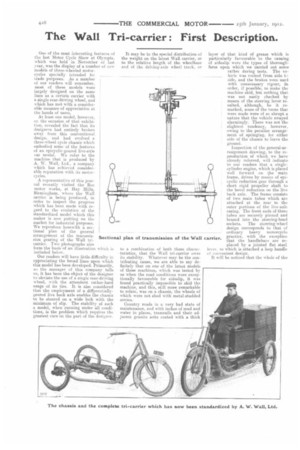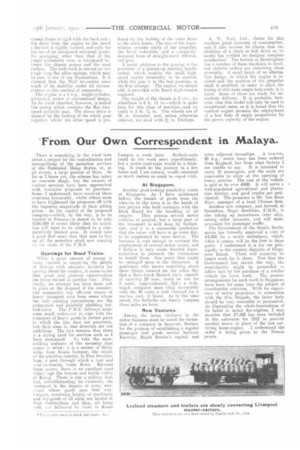The Wall Tri.carrier : First Description.
Page 6

Page 7

If you've noticed an error in this article please click here to report it so we can fix it.
One of the most interesting features of the last Motor Cycle Show at Olympia, which was held in November of last year, was the display of a number of new models of three-wheeled motorcycles specially intended tor trade purposes. As a number of our readers will remember, must of these models were largely designed on the same lines as a certain carrier with a single rear-driving wheel, and which has met with a considerable measure of appreciation at the hands of users.
At least one model, however, on the occasion of that exhibition, revealed the fact that its designers had entirely broken away from this conventional design, and had evolved a three-wheel cycle chassis which embodied some of the features of an epicyclicgeared live-axle car model. We refer to the machine that is produced by A. W. Wall, Ltd., a company which has achieved considerable reputation with its motorcycles.
A representative of this journal recently visited the Roe motor works, at Hay Mills, Birmingham, where the Wall carrier is being produced, in order to inspect the progress which has been made with regard to the evolution of the standardized model which this maker is now putting on the market for industrial purposes. We reproduce herewith a sectional plan of the general arrangement of the transmission gearing of the Wall tricarrier. Two photographs also form the basis of an illustration which is included below.
Our readers will have little difficulty in appreciating the broad lines upon which this model has been developed. Primarily, so the manager of this company tells us, it has been the object of the designer to obviate the use of a single rear-driving wheel, with the attendant rather-hard usage of its tire. It is also considered that the employment of a differentiallygeared live back axle enables the chassis to be steered on a wide lock with the minimum of slip. The stability of such a model, when running under all conditions, is the problem which requires the greatest care on the part of the designer. Sectio
It may be to the special distribution of the weight on the latest Wall carrier, or to the relative length of the wheelbase and of the driving-axle wheel track, or
to a combination of both these chaiseteristics, that the Wall tri-carrier owes its stability. Whatever may be the contributing cause, we are able to say definitely that on one of the latest models of these machines, which was tested by us when the road conditions were exceptionally favourable for sideslip, it was found practically impossible to skid the machine, and this, still more remarkable to relate, was on a chassis, the wheels of which were not shod with metal-studded covers.
Country roads in a very bad state of maintenance, and with inches of mud and water in places, tramrails and their adjacent granite setts coated with a thick layer of that kind of grease which is particularly favourable to the causing of sideslip were the types of thoroughfares upon which we carried out some
rather daring tests. The ve
hicle was rocked from side side, and the brakes were used with unnecessary rigour, in order, if possible, to make. the machine skid, but nothing that was not easily checked by means of the steering lever resuited, although, be it remarked, some of the turns that were made were of so abrupt a nature that the vehicle swayed alarmingly. There was not the slightest tendency, however,
owing to the peculiar arrange ment of springing, for either side of the chassis to leave the ground.
Inspection of the general-arrangenkent drawing, to the reproduction of which we have already referred, will indicate, to our readers that a singlecylinder engine, which is placed well forward on the main frame, drives by means of epicyclic reduction gear through a short rigid propeller shaft tothe bevel reduction on the live back axle. The frame consists of two main tubes which are attached at the rear to the outer portions of the live-axle casing. The front ends of these tubes are securely pinned and brazed into the steering-head sockets. The steering-wheel design corresponds to that of ordinary heavy motorcycle practice, with the exception that the handlebars are replaced by a jointed flat steel lever, to which is attached a loon handle It will be noticed that the whole of the chassis frame is rigid with the back axle; the drive from the engine to the bevel ieduction is rigidly located, and calls for the use of no interposed universal joints. No springing, other than that of the ample pneumatic tires, is interposed be tween the chassis proper and the road surface. The bodywork is carried on two single long flat. plate springs, which may be seen in one of our illustrations. It is claimed that the Wall tri-carrier owes much of its stability under all circumeta.nces. to this method of suspension. The engine is a 4 h.p., single-cylinder, air-cooled, motor of conventional design. To its crank chamber, however, is bolted the casing which contains the Roc twospeed epicyclic gear. The direct drive is secured by the locking of the whole gear together„ whilst the other speed is pro duced by the locking of the outer drum to the main frame. The rest of the transmission consists solely of the propeller, the bevel reduction, and a compactlydesigned form of straight-tooth differential gear. A useful addition to the gearing is the provision of a geared-up starting handle socket, which enables the small highspeed engine invariably to be started, while the gear is in the free position, at the first attempt. The engine, we should add, is provided with Bosch high-tension magneto. The weight of the chassis is 3 cwt., its wheelbase is 6 ft. 11 in.—which is quite long for this class of machine—and its track is 3 ft. 7-i in. The wheels are of 26 in. diameter, and, unless otherwise ordered, are shod with 21 in. Dunlops. A. W. Wall, Ltd., claims for this machine great economy of consumption, and it also assures its clients that, the abolition of a chain or belt drive on its model has yielded its designer complete satisfaction. The factory at Birmingham has a number of these machines in hand, but definite orders are absorbing these premptly. A small batch of an alternafive design, in which the engine is inclined and the position of the propeller shaft is modified, in order to allow the fitting of still more ample bodywork, is in hand. Some of these are ready for immediate delivery. It is probable, however, that this model will only be used in exceptional cases, as it is found that the vertical engine permits the employment of a box body of ample proportions for the power capacity of the engine.Tags






















